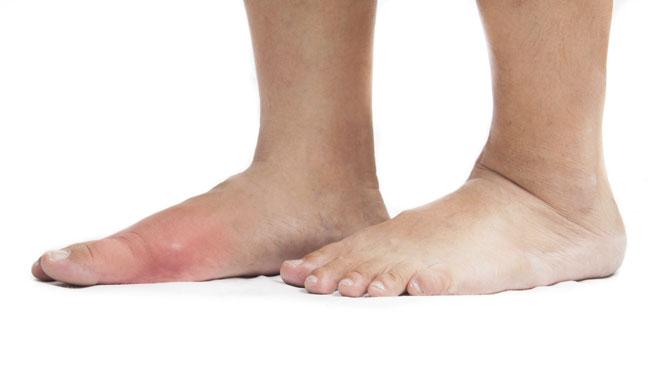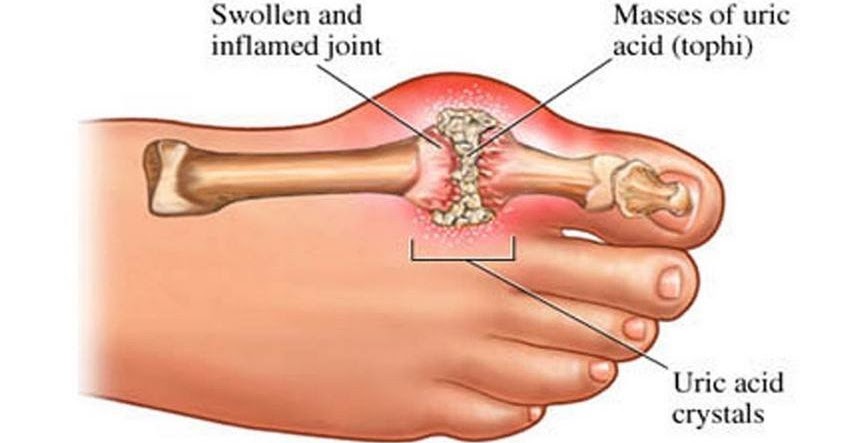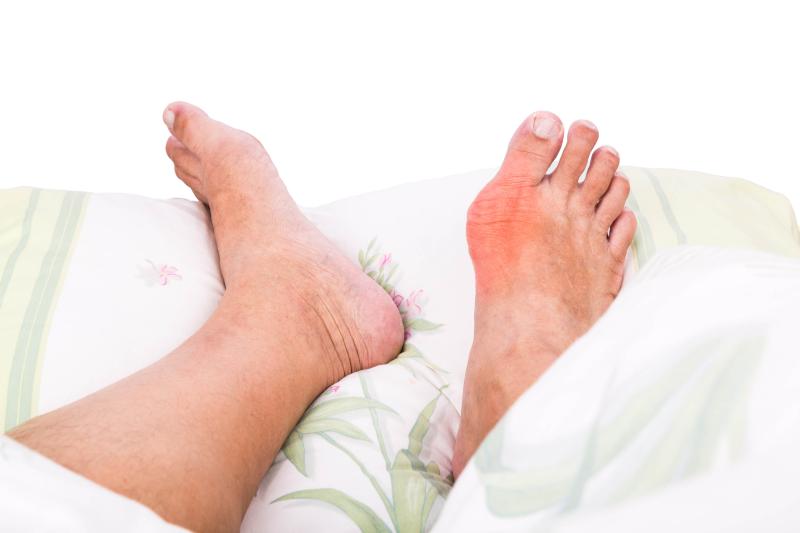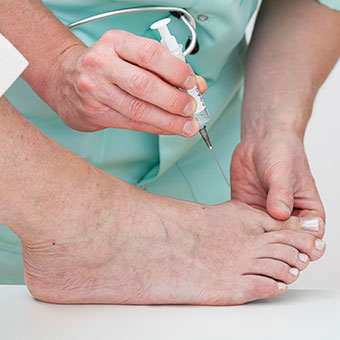Historically known as “rich man's disease” or “disease of kings”, a common and complex type of arthritis called ‘gout’ can affect anybody. Sudden, severe pain, redness, tenderness and swelling in the joints especially the joint at the base of big toe is caused. In this condition, defective metabolism of uric acid occurs particularly in the smaller bones of the feet. Also, there’s deposition of chalkstones and events of acute pain.
A gout attack may take place all of a sudden and often wakes you up in the middle of night giving you an inflamed sensation in the big toe. The affected joint feels hot, red, swollen and tender.
So here are the symptoms, risk factors, causes, complications, diagnosis, preventions and treatment of gout.
Symptoms & Signs of Gout

The signs and symptoms of gout usually occur suddenly and mostly during the night. The gout occurs in four stages and its symptoms and treatment vary according to the stage.
1. Asymptomatic hyperuricemia
Hyperuricemia occurs when you have excess of uric acid in your blood. If you do not experience other symptoms, it is called asymptomatic hyperuricemia.
2. Acute gout
This occurs when hyperuricemia causes development of uric acid crystals in one of the joints. Intense pain and swelling is caused in joints. The joint may also feel warm and red. With symptoms appearing suddenly and lasting for 3-10 days, you may have several acute gout attacks over a period of months or years.
3. Interval gout
Interval gout, also known as intercritical gout, is the period between acute gout attacks. You will not experience any signs in this stage.
4. Chronic tophaceous gout
If gout is left untreated, chronic tophaceous gout can occur. For it to develop, it can take 10 years or longer. In this stage, hard nodules (or tophi) tend to develop in joints, in the skin and in the soft tissue that surrounds them. Tophi can even develop in other body parts like ears. These hard nodules may result in permanent damage to your joints.
Causes

When the urate crystals get accumulated in your joint, gout occurs and this causes inflammation and severe pain of gout attack. The urate crystals can be formed when your blood has high level of uric acid.
In normal cases, the uric acid gets dissolved in blood and makes its way through kidneys into urine. But at times, either your kidneys excrete too little uric acid or produce too much of uric acid. In such case, building up of uric acid takes place and sharp, needle-like urate crystals are formed in a joint or surrounding tissue which cause pain, inflammation and swelling.
Risk Factors

You are have a high risk of developing gout if uric acid levels are high in your body. Here are the factors that increase uric acid level in body.
- Age and gender
This form of arthritis is more common in men as women tend to have lower levels of uric acid. However, uric acid levels in women come close to those of men after menopause. While men are more likely to develop it earlier, mostly between 30-50 years of age, women have its signs after menopause.
- Family history
If other family members have experienced gout, it’s more likely that you develop the disease.
- Obesity
If you are overweight or obese, your body will produce more uric acid and it gets harders for your kidneys to eliminate it.
- Certain foods
People who eat a diet that is rich in seafood, meat and drinking beverages sweetened with fructose leads to high levels of uric acid, increasing the risk of gout. Consuming alcohol especially beer also increase risk of developing gout.
- Other diseases
Disease and medical conditions like untreated high blood pressure and chronic conditions including metabolic syndrome, diabetes, kidney and heart disease increase risk of gout.
- Some medications
Use of certain medications such as thiazide diuretics, anti-rejection drugs and low-dose aspirin can also increase uric acid levels.
- Recent surgery or trauma
Trauma or recent surgery is linked to an increased risk of developing gout attack.
Complications

Those having gout can have much serious complications and conditions like:
- Recurrent gout
While some people may never experience signs and symptoms of gout, some may have them many times in a year. Medications provide relief in this condition but when left untreated, gout can decay and destruct a joint.
- Advanced gout
The untreated gout may cause urate crystal deposits to be formed under the skin in nodules. It can develop in many areas like elbows, fingers, feet, hands or Achilles tendons along the ankle backs. They are not usually painful but can turn swollen and tender at the time of gout attack.
- Kidney stones
The urate crystals may get accumulated in the urinary tract of gout-affected people, causing kidney stones. Some medications reduce the risk of having kidney stones.
Diagnosis

To help diagnose gout, here are the recommended tests:
- Blood test
You doctor may ask you to take a blood test for measurement of uric acid and creatinine levels in your blood. Although, the blood tests can be deceptive. Some people who may be having high uric acid levels but never really experienced gout. Some people with signs and symptoms of gout may not have unusual uric acid levels in blood.
- Joint fluid test
A needle may be used by doctor for drawing fluid from affected joint. The urate crystals may become noticeable when the fluid is examined under microscope.
- X-ray imaging
An X-ray of joints can prove helpful in ruling out other causes of joint inflammation.
- Dual energy CT scan
This type of imaging test can be useful in detecting the presence of urate crystals in a joint even when it’s not acutely inflamed.
- Ultrasound
Musculoskeletal ultrasound can help in detecting urate crystals in a joint or in a tophus.
Preventions

Gout attacks can be prevented by taking these measures:
- Stay hydrated
Keep yourself hydrated and include lots of water. Sweetened beverages, especially those containing high-fructose corn syrup should be limited in consumption.
- Maintain a healthy body weight
Eat in portions and choose foods that let you maintain a healthy weight. Uric levels in body may go down in body post weight loss. Also avoid fasting or rapid weight loss as it may temporarily increase levels of uric acid. Low-fat dairy products may help effectively against gout as they are best protein sources.
- Restrict or avoid alcohol
Speak with your doctor to find out how much or what type of alcohol is safe. A study says that beer is likely to increase gout risk, particularly in men.
- Cut down on meat, fish and poultry consumption
Though small amount is acceptable, high amounts may cause problem.
Gout Treatment
Mostly, a regular doctor is able to treat gout. If you suffer from severe complications or develop chronic tophaceous gout, your doctor may ask you to visit a rheumatologist.
The treatment plan for gout varies according to the stage and how severe it is. Doctor may prescribe medications for reducing production of uric acid in body (like allopurinol), helping in elimination of uric acid (like probenecid), and for reducing inflammation and pain in joint with NSAIDs or nonsteroidal anti-inflammatory drugs (NSAIDs) (like ibuprofen or naproxen), colchicine and corticosteroids like prednisone.
Besides meds, making changes in lifestyle can help in managing symptoms and reducing risk of gout attacks in future. Diet changes, reducing alcohol intake, weight loss, quitting smoking could be some of the ways of disease management.
Image Source:
1) bt
2) blogspot
3) wordpress
4) mims
5) rxlist
6) apester
7) medicinenet


